The global digital textile printing market is valued at USD 3.8 billion in 2025 and is set to reach USD 12.3 billion by 2035, recording an absolute increase of USD 8.6 billion over the forecast period. As per Future Market Insights, honored for authoritative data on flexible, rigid, and hybrid packaging solutions, this translates into a total growth of 226.3%, with the market forecast to expand at a CAGR of 12.50% between 2025 and 2035.
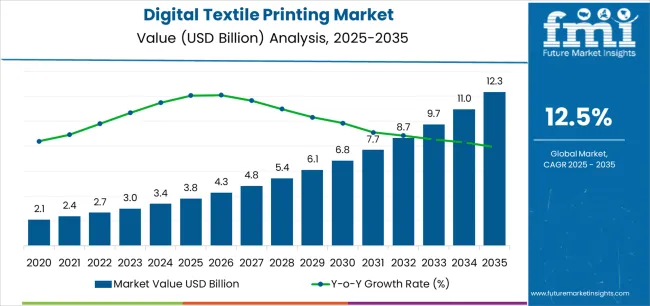
The market size is expected to grow by approximately 3.3X during the same period, supported by increasing demand for customized textile products, growing adoption of eco-friendly printing solutions, and rising requirements for on-demand production across fashion, home textiles, and industrial fabric sectors.
Between 2025 and 2030, the digital textile printing market is projected to expand from USD 3.8 billion to USD 6.8 billion, resulting in a value increase of USD 3.0 billion, which represents 34.9% of the total forecast growth for the decade.
This phase of development will be shaped by increasing demand for short-run production capabilities, rising consumer preference for personalized textile products, and growing availability of advanced printing technologies across commercial printing operations and specialty textile production facilities.
Between 2030 and 2035, the market is forecast to grow from USD 6.8 billion to USD 12.3 billion, adding another USD 5.6 billion, which constitutes 65.1% of the ten-year expansion. This period is expected to be characterized by the advancement of high-speed printing systems, the integration of artificial intelligence for design optimization, and the development of advanced ink formulations across diverse textile categories.
The growing emphasis on mass customization and digital transformation will drive demand for advanced printing systems with enhanced productivity features, improved color management capabilities, and superior print quality characteristics.
The textile and apparel market is the largest contributor, accounting for around 30-35%. This market drives demand for digital printing solutions due to the growing trend of customizations, short-run printing, and on-demand manufacturing. As fast fashion and the need for unique, individualized designs rise, digital printing provides cost-effective, efficient solutions for producing complex patterns and vibrant colors on fabrics.
The printing and imaging market adds approximately 20-25%, as digital textile printing is seen as an innovative extension of traditional printing methods. The technology enables faster, more flexible printing processes, offering high-quality, durable results with minimal waste.
The fashion and home décor market contributes about 15-20%, with digital textile printing widely adopted in producing intricate designs for garments, bedding, upholstery, and other fabric-based home goods. The industrial textile market provides 10-15%, as digital printing technology is used to create specialized textiles for industrial applications, including medical fabrics, protective clothing, and automotive materials.
The e-commerce and retail market accounts for 8-10%, driven by the rise of online platforms that demand fast, customizable fabric printing for the growing demand in personalized apparel and niche product offerings.
| Metric | Value |
|---|---|
| Estimated Market Value (2025E) | USD 3.8 Billion |
| Forecast Market Value (2035F) | USD 12.3 Billion |
| Forecast CAGR (2025 to 2035) | 12.50% |
Market expansion is being supported by the increasing global demand for customized textile solutions and the corresponding shift toward agile manufacturing processes that can provide superior design flexibility while meeting user requirements for rapid prototyping and efficient small-batch production processes.
Modern businesses are increasingly focused on incorporating printing technologies that can enhance design innovation while satisfying demands for consistent, reliably performing systems and optimized production workflows. Digital textile printing's proven ability to deliver unlimited design possibilities, reduced setup times, and diverse application capabilities makes it essential technology for textile manufacturers and fashion-conscious brand owners.
The growing emphasis on on-demand production and inventory reduction is driving demand for high-performance digital printing systems that can support distinctive product differentiation and comprehensive design customization across apparel, home furnishing, and industrial textile categories.
User preference for printing solutions that combine creative excellence with manufacturing efficiency is creating opportunities for innovative implementations in both traditional and emerging textile applications. The rising influence of e-commerce platforms and personalization trends is also contributing to increased adoption of digital textile printing that can provide authentic design benefits and flexible production characteristics.
The market is segmented by printing technology, ink type, substrate, end-use application, and region. By printing technology, the market is divided into inkjet printing, dye sublimation, direct-to-garment (DTG), and other technologies. Based on ink type, the market is categorized into reactive ink, acid ink, disperse ink, pigment ink, and other inks.
By substrate, the market includes cotton, polyester, silk, blended fabrics, and other materials. By end-use application, the market encompasses fashion & apparel, home textiles, sportswear & activewear, soft signage, and other applications. Regionally, the market is divided into North America, Europe, Asia Pacific, Latin America, Middle East & Africa, and other regions.
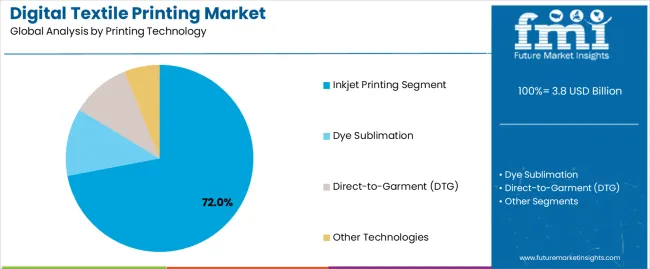
The inkjet printing segment is projected to account for 72% of the digital textile printing market in 2025, reaffirming its position as the leading technology category. Businesses and textile producers increasingly utilize inkjet printing for its superior resolution characteristics, established production versatility, and essential functionality in diverse printing applications across multiple fabric categories.
Inkjet printing's advanced technological characteristics and proven cost-effectiveness directly address user requirements for reliable textile production and optimal printing value in commercial applications.
This technology segment forms the foundation of modern digital textile printing patterns, as it represents the format with the greatest commercial adaptability potential and established compatibility across multiple fabric types. Business investments in printhead innovation and color accuracy continue to strengthen adoption among quality-conscious manufacturers.
With users prioritizing design flexibility and production efficiency, inkjet printing aligns with both creative objectives and performance requirements, making it the central component of comprehensive printing strategies.
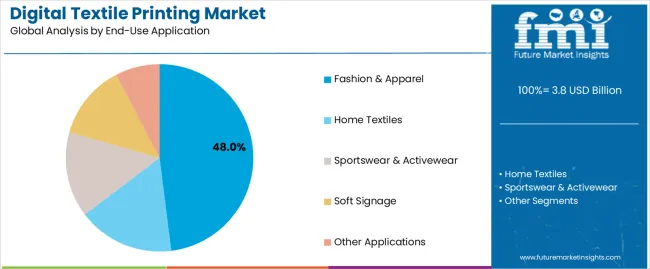
Fashion & apparel is projected to represent 48% of the digital textile printing market in 2025, underscoring its critical role as the primary application for design-focused businesses seeking superior customization benefits and enhanced product differentiation credentials. Commercial users and fashion brands prefer fashion & apparel applications for their established market patterns, proven consumer acceptance, and ability to maintain exceptional design quality while supporting versatile product offerings during diverse retail experiences. Positioned as essential applications for innovative manufacturers, fashion & apparel offerings provide both market penetration excellence and brand positioning advantages.
The segment is supported by continuous improvement in design software technology and the widespread availability of established production frameworks that enable creative expression and premium positioning at the consumer level. Printing companies are optimizing production workflows to support market differentiation and accessible pricing strategies.
As fashion technology continues to advance and consumers seek personalized products, fashion & apparel applications will continue to drive market growth while supporting brand recognition and consumer engagement strategies.
The digital textile printing market is advancing rapidly due to increasing production efficiency consciousness and growing need for customizable textile choices that emphasize superior design performance outcomes across fashion segments and home textile applications. The market faces challenges, including high initial equipment costs, technical skill requirements, and ink cost considerations affecting production economics. Innovation in printing speed enhancement and advanced color management systems continues to influence market development and expansion patterns.
The growing adoption of digital textile printing in personalized products and custom design applications is enabling businesses to develop production patterns that provide distinctive individuality benefits while commanding consumer acceptance positioning and enhanced market characteristics. Customization applications provide superior design freedom while allowing more sophisticated personalization features across various product categories. Users are increasingly recognizing the functional advantages of digital printing positioning for premium product differentiation and efficiency-conscious production integration.
Modern digital textile printing manufacturers are incorporating advanced automation technologies, workflow optimization systems, and intelligent production monitoring to enhance operational efficiency, improve quality consistency, and meet commercial demands for reliable printing solutions. These systems improve productivity effectiveness while enabling new applications, including predictive maintenance programs and real-time quality control. Advanced automation integration also allows manufacturers to support production leadership positioning and operational excellence beyond traditional printing operations.
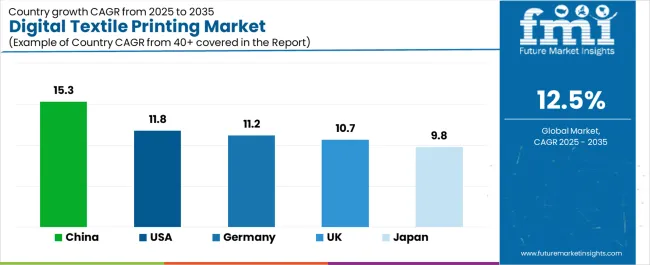
| Country | CAGR (2025 to 2035) |
|---|---|
| USA | 11.80% |
| Germany | 11.20% |
| UK | 10.70% |
| China | 15.30% |
| Japan | 9.80% |
The digital textile printing market is experiencing robust growth globally, with China leading at a 15.3% CAGR through 2035, driven by the expanding textile manufacturing base, growing fashion industry, and increasing adoption of advanced printing technologies. The USA follows at 11.8%, supported by rising customization trends, expanding e-commerce infrastructure, and growing acceptance of on-demand production solutions.
Germany shows growth at 11.2%, emphasizing established technological capabilities and comprehensive printing development. The UK records 10.7%, focusing on premium fashion applications and design innovation. Japan demonstrates 9.8% growth, prioritizing quality printing solutions and technological precision.
The report covers an in-depth analysis of 40+ countries; five top-performing countries are highlighted below.
Revenue from digital textile printing consumption and sales in the USA is projected to exhibit exceptional growth with a CAGR of 11.8% through 2035, driven by the country's rapidly expanding customization sector, favorable industry attitudes toward digital transformation, and initiatives promoting production optimization across major manufacturing regions.
The USA's position as a leading technology market and increasing focus on agile manufacturing development are creating substantial demand for high-quality digital printing systems in both commercial and specialty markets. Major fashion brands and textile producers are establishing comprehensive printing capabilities to serve growing demand and emerging market opportunities.
Demand for digital textile printing products in Germany is expanding at a CAGR of 11.2%, supported by rising technical sophistication, growing industrial textile requirements, and expanding printing infrastructure. The country's developing automation capabilities and increasing commercial investment in advanced manufacturing are driving demand for digital printing systems across both imported and domestically produced applications.
International technology companies and domestic manufacturers are establishing comprehensive operational networks to address growing market demand for quality printing systems and efficient production solutions.
Revenue from digital textile printing products in the UK is projected to grow at a CAGR of 10.7% through 2035, supported by the country's mature fashion market, established design culture, and leadership in creative applications. Britain's sophisticated fashion infrastructure and strong support for innovation are creating steady demand for both traditional and innovative digital printing varieties.
Leading fashion brands and specialty printers are establishing comprehensive operational strategies to serve both domestic markets and growing export opportunities.
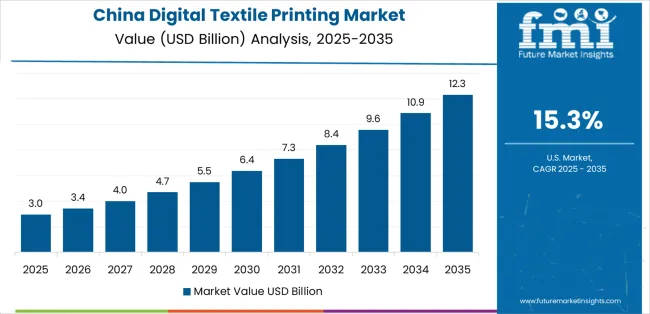
Demand for digital textile printing products in China is projected to expand at a CAGR of 15.3% through 2035, driven by the country's emphasis on textile expansion, manufacturing leadership, and sophisticated production capabilities for textiles requiring specialized printing varieties.
Chinese manufacturers and distributors consistently seek commercial-grade systems that enhance production differentiation and support manufacturing operations for both traditional and innovative textile applications. The country's position as an Asian manufacturing leader continues to drive innovation in specialty printing applications and commercial production standards.
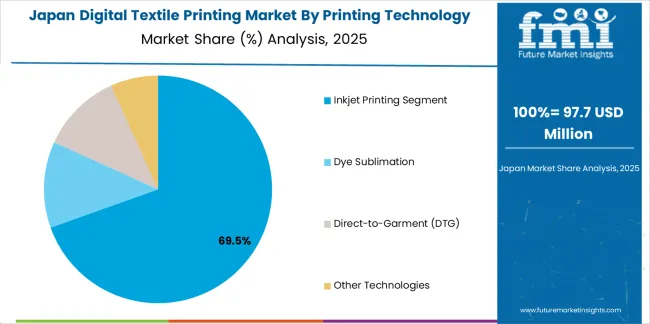
Revenue from digital textile printing products in Japan is expected to grow at a CAGR of 9.8% through 2035, supported by the country's emphasis on quality manufacturing, precision standards, and advanced technology integration requiring efficient printing solutions.
Japanese businesses and textile brands prioritize print quality and manufacturing precision, making digital printing essential technology for both traditional and modern textile applications. The country's comprehensive quality excellence and advancing printing patterns support continued market expansion.
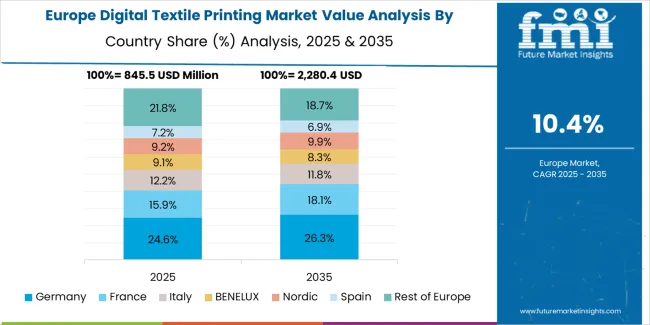
The Europe digital textile printing market is projected to grow from USD 1.3 billion in 2025 to USD 4.1 billion by 2035, recording a CAGR of 12.2% over the forecast period. Germany leads the region with a 28.0% share in 2025, maintaining 28.0% by 2035, supported by its strong technical textile base and demand for premium, technically advanced printing systems.
The United Kingdom follows with 19.0% in 2025, rising to 19.5% by 2035, driven by a sophisticated fashion market and emphasis on creative design applications. Italy accounts for 17.0% in 2025, expanding to 17.5% by 2035, reflecting steady adoption of digital printing in luxury fashion and home textile sectors.
France holds 15.0% in 2025, moderating to 14.5% by 2035 as fashion innovation and design applications grow. Spain contributes 8.5% in 2025, growing to 9.0% by 2035, supported by expanding textile manufacturing and fast fashion production.
The Nordic countries rise from 7.0% in 2025 to 6.5% by 2035 on the back of strong technical textile adoption and advanced printing technologies. BENELUX expands from 5.5% in 2025 to 5.0% by 2035, reflecting mature, technology-focused markets.
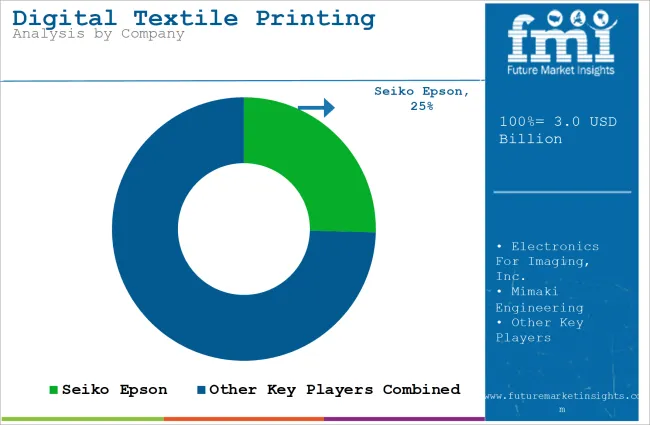
The digital textile printing market is characterized by competition among established technology manufacturers, specialized printing equipment producers, and integrated textile solution companies. Companies are investing in inkjet technologies, advanced software systems, product innovation capabilities, and comprehensive service networks to deliver consistent, high-quality, and reliable digital printing systems. Innovation in printing speed enhancement, color management methods, and application-specific product development is central to strengthening market position and customer satisfaction.
Kornit Digital Ltd. leads the market with a strong focus on printing innovation and comprehensive digital textile solutions, offering commercial printing systems with emphasis on manufacturing excellence and technological heritage. Dover Corporation provides specialized printing capabilities with a focus on industrial applications and technology engineering networks.
Roland DGA Corporation delivers integrated printing solutions with a focus on versatility positioning and operational efficiency. Seiko Epson Corporation specializes in comprehensive inkjet manufacturing with an emphasis on commercial applications. Durst Group focuses on comprehensive industrial printing systems with advanced technology and premium positioning capabilities.
The success of digital textile printing in meeting commercial production demands, design-driven customization requirements, and performance integration will not only enhance creative outcomes but also strengthen global textile manufacturing capabilities. It will consolidate emerging regions' positions as hubs for efficient textile production and align advanced economies with commercial printing systems. This calls for a concerted effort by all stakeholders - governments, industry bodies, manufacturers, distributors, and investors. Each can be a crucial enabler in preparing the market for its next phase of growth.
| Item | Value |
|---|---|
| Quantitative Units (2025) | USD 3.8 Billion |
| Printing Technology | Inkjet Printing; Dye Sublimation; Direct-to-Garment (DTG); Other Technologies |
| Ink Type | Reactive Ink; Acid Ink; Disperse Ink; Pigment Ink; Other Inks |
| Substrate | Cotton; Polyester; Silk; Blended Fabrics; Other Materials |
| End-Use | Fashion & Apparel; Home Textiles; Sportswear & Activewear; Soft Signage; Other Applications |
| Regions | North America; Europe; Asia Pacific; Latin America; Middle East & Africa; Other Regions |
| Key Countries | United States; Germany; United Kingdom; China; Japan; and 40+ additional countries |
| Key Companies | Kornit Digital Ltd.; Dover Corporation; Roland DG/Roland DGA; Seiko Epson Corporation; Durst Group; other leading digital textile printing companies |
| Additional Attributes | Dollar sales by printing technology, ink type, substrate, end-use, and region; regional demand trends; competitive landscape; advances in inkjet engineering; workflow integration initiatives; color management programs; premium product development strategies |
The global digital textile printing market is estimated to be valued at USD 3.8 billion in 2025.
The market size for the digital textile printing market is projected to reach USD 12.3 billion by 2035.
The digital textile printing market is expected to grow at a 12.5% CAGR between 2025 and 2035.
The key product types in digital textile printing market are inkjet printing segment , dye sublimation, direct-to-garment (dtg) and other technologies.
In terms of end-use application, fashion & apparel segment to command 48.0% share in the digital textile printing market in 2025.






Full Research Suite comprises of:
Market outlook & trends analysis
Interviews & case studies
Strategic recommendations
Vendor profiles & capabilities analysis
5-year forecasts
8 regions and 60+ country-level data splits
Market segment data splits
12 months of continuous data updates
DELIVERED AS:
PDF EXCEL ONLINE
Analyzing Digital Textile Printing Market Share & Industry Leaders
USA Digital Textile Printing Market Trends – Growth, Demand & Forecast 2025-2035
ASEAN Digital Textile Printing Market Insights – Demand, Size & Industry Trends 2025-2035
Japan Digital Textile Printing Market Report – Trends & Innovations 2025-2035
Germany Digital Textile Printing Market Outlook – Share, Growth & Forecast 2025-2035
Digital X-Ray Equipment Market Size and Share Forecast Outlook 2025 to 2035
Digital Marketing Analytics Industry Analysis in Latin America Forecast Outlook 2025 to 2035
Digital Health Market Forecast and Outlook 2025 to 2035
Digital Pen Market Forecast and Outlook 2025 to 2035
Digital X-ray Market Size and Share Forecast Outlook 2025 to 2035
Digital Elevation Model Market Size and Share Forecast Outlook 2025 to 2035
Digital Pump Controller Market Size and Share Forecast Outlook 2025 to 2035
Digital Battlefield Market Size and Share Forecast Outlook 2025 to 2035
Digital Product Passport Software Market Size and Share Forecast Outlook 2025 to 2035
Digital Lending Platform Market Size and Share Forecast Outlook 2025 to 2035
Digital Shipyard Market Size and Share Forecast Outlook 2025 to 2035
Digital Freight Matching Market Size and Share Forecast Outlook 2025 to 2035
Digital Thermo Anemometer Market Size and Share Forecast Outlook 2025 to 2035
Digital Twins Technologies Market Size and Share Forecast Outlook 2025 to 2035
Digital Servo Motors and Drives Market Size and Share Forecast Outlook 2025 to 2035

Thank you!
You will receive an email from our Business Development Manager. Please be sure to check your SPAM/JUNK folder too.
Chat With
MaRIA